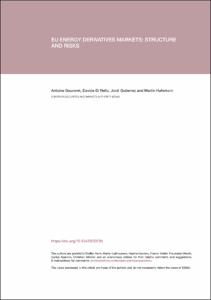EU Energy derivatives markets: structure and risks
Autor
Fecha de publicación
30-may-2023
Descripción física
30 p.
Resumen
Energy derivatives markets were thrown into turmoil following Russia’s invasion of
Ukraine, as the prices of natural gas and power soared amid high volatility and a
significant deterioration in market liquidity. Prices surged in March 2022, before
declining in Spring and then rebounding to reach historical peaks at end-August 2022.
The sharp price increases triggered large margin calls on derivatives positions, resulting
in liquidity stress for some firms using derivatives as hedges against price declines,
energy utilities in particular. The liquidity demands were so high that some EU countries
introduced public support mechanisms in the form of loans and public guarantees, and
a few energy firms were bailed out. Therefore, it is crucial to understand the structure
and functioning of energy derivatives markets. This article provides an overview of EU
energy derivatives markets and assesses the risks for financial stability. Unlike other
financial markets, non-financial corporates play a key role in energy markets by trading
on exchanges and over the counter. The market is characterised by a high degree of
concentration in clearing and trading activities, as evidenced by network analysis, and
some energy firms hold relatively large positions in the market. In this context, liquidity
and concentration risks are among the main vulnerabilities identified, along with data
fragmentation and data gaps. The recent migration of some of this activity from
exchange-traded to over-the-counter derivatives markets raises concerns over limited
transparency and more bespoke margin and collateral requirements.
Notas
Artículo de revista
Publicado en
Financial Stability Review / Banco de España, 44 (Spring 2023), p. 37-66
Otras versiones
Materias
Financial stability; Energy derivatives; Collateral; Margins; Energía y política energética; Comportamiento y estructura de los mercados; Países de la UE
Aparece en las colecciones:












